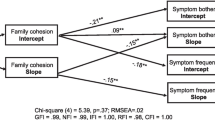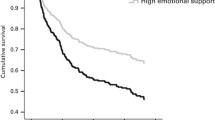Abstract
A longitudinally study was conducted among 42 bone marrow transplantation (BMT) patients to investigate the association between pretransplant psychosocial variables and psychophysiological outcomes during the immediate convalescence period. Family relationships (cohesion, expressiveness, and conflict) and coping resources (cognitive, social, emotional, spiritual/philosophical, and physical resources) were assessed on the admission day (Day −7 Time 1). Data on psychological distress and pain intensity were obtained on Day +7 (Time 2) and Day +14 (Time 3). The average scores at Times 2 and 3 were computed to indicate the overall adjustments of the patients during the hospitalization period after the day of actual transplant (Day 0). It was shown that higher expressiveness family relationships and higher resources to cope effectively with stressful situations were associated with less psychological distress during the above period. Both pretransplant psychosocial variables were not associated with pain intensity during hospitalization. Allogeneic transplant patients reported higher pain intensity than did autologous transplant patients. Psychological distress and pain intensity were positively correlated with each other. Our findings show that pretransplant family relationships and coping resources associate moderately with psychological distress during the immediate convalescent period of BMT. The present findings support the family-centered approach to BMT care and provide a scientific basis for pretransplant psychosocial interventions.
Similar content being viewed by others
REFERENCES
Andrykowski, M. A. (1994). Psychiatric and psychosocial aspects of bone marrow transplantation. Psychosomatics, 35(1), 13–24.
Andrykowski, M., & McQuellon, R. P. (1998). Bone marrow transplantation. In J. C. Holland (Ed.), Psycho-oncology (pp. 289–299). New York: Oxford University Press.
Baider, L., Peretz, T., & Kaplan, De-Nour A. (1997). The effect of behavioral intervention on the psychological distress of holocaust survivors with cancer. Psychotherapy and Psychosomatics, 66(1), 44–49.
Barid, C. L., & Bell, P. A. (1995). Place attachment, isolation, and the power of a window in a hospital environment: A case study. Psychological Reports, 76, 847–850.
Bishop, G.D. (1993). The sense of coherence as a resource in dealing with stress. Psychologia: An International Journal of Psychology in the Orient, 36(4), 259–265.
Brown, H. N., & Kelly, M. J. (1976). Stages of bone marrow transplantation: Apsychiatric perspective. Psychosomatic Medicine, 38, 439–447.
Chapko, M. K., Syrjala, K. L., Schilter, L., Cummings, C., & Sullivan, K. M. (1989). Chemoradiotherapy toxicity during bone marrow transplantation: Time course and variation in pain and nausea. Bone Marrow Transplantation, 4, 181–186.
Coenson, C., & Dimsdale, J. E. (1994). Psychiatric liaison on a bone marrow transplantation unit. General Hospital Psychiatry, 16, 131–134.
Decker, W.A. (1995). Psychosocial considerations for bone marrow transplant recipients. Critical Care Nursing Quarterly, 17(4), 67–73.
Dermatis, H., & Lesko, M. (1990). Psychological distress in parents consenting to child's bone marrow transplantation. Bone Marrow Transplantation, 6, 411–417.
Derogatis, L. R. (1993). Brief Symptom Inventory. Administration, scoring, and procedures manual. Minneapolis, MN: National Computer Systems.
Derogatis, L. R., Lipman, R. S., Rickels, K., Uhlenhuth, E., & Covi, L. (1974). The Hopkins Symptom Checklist (HSCL): A self-report symptom inventory. Behavioural Science, 19, 1–15.
Evers, A.W., Kraaimaat, F.W., Geenen, R., & Bijlsma, J.W. (1997). Determinants of psychological distress and its course in the first year after diagnosis in rheumatoid arthritis patients. Journal of Behavioral Medicine, 20(5), 489–504.
Fife, B. L., Huster, G. A., Cornetta, K. G., Kennedy, V. N., Akard, L. P., & Broun, E. R. (2000). Longitudinal study of adpatation to the stress of bone marrow transplantation. Journal of Clinical Oncology, 18(7), 1539–1549.
Foley, K.M. (1986). The clinical use of analgesics. In L.R. Derogatis (Ed.), Clinical psychopharmacology (pp. 269–289). Menlo Park, CA: Addison-Wesley.
Futterman, A. D., Wellisch, D. K., Bond, G., & Carr, C. R. (1991). The psychosocial levels system. A new rating scale to identify and assess emotional difficulties during bone marrow transplantation. Psychosomatics, 32(2), 177–186.
Gaston-Johansson, F., & Foxall, M. (1996). Psychological correlates of quality of life across the autologous bone marrow transplant experience. Cancer Nursing, 19(3), 170–176.
Gaston-Johansson, F., Franco, T., & Zimmerman, L. (1992). Pain and psychological distress in patients undergoing autologous bone marrow transplantation. Oncology Nursing Forum, 19(1), 41–48.
Ginter, G. G., West, J. D., & Zarski, J. J. (1989). Learned resourcefulness and situation-specific coping with stress. The Journal of Psychology, 23(3), 295–304.
Grassi, L., Rosti, G., Albertazzi, L., & Marangolo, M. (1996). Psychological stress symptoms before and after autologous bone marrow transplantation in patients with solid tumors. Bone Marrow Transplantation, 17, 843–847.
Grulke, N., Bailer, H., Tschuschke, V., Bunjes, D., Arnold, R., Hertenstein, B., et al. (1998). Coping strategies, changes in coping intensity during bone marrow transplantation, and relationships with long-term survival-results of a prospective study. Paper presented at the 4th International Congress of Adaptation of BMT 175 Psycho-Oncology on Integrative Concepts in Treatment and Research, Hamburg, Germany.
Hammer, A. L., & Marting, M. S. (1988). Manual for the Coping Resources Inventory. California: Consulting Psychologists Press.
Jenkins, P. L., Lester, H., Alexander, J., & Whittaker, J. (1994). A prospective study of psychosocial morbidity in adult bone marrow transplant recipients. Psychosomatics, 35(4), 361–367.
Jenkins, P. L., Linngton, A., & Whittaker, J.A. (1991). A retrospective study of psychosocial morbidity in bone marrow transplant recipients. Psychosomatics, 32(1), 65–71.
Jenkins, R. A., & Pargament, K. I. (1995). Religion and spirituality as resources for coping with cancer. Journal of Psychosocial Oncology, 13(1/2), 51–74.
Jessop, D. (1998). Evidence for mind‐body connection increases. The Lancet, 351(9110), 1185.
Krohne, H. W. (1990). Personality as a mediator between objective events and their subjective representation. Psychological Inquiry, 1(1), 26–29.
Lazarus, R. S. (1990a). Author's response. Psychological Inquiry, 1(1), 41–51.
Lazarus, R. S. (1990b). heory-based stress measurement. Psychological Inquiry, 1(1), 3–13.
Lesko, L.M. (1990). Bone marrow transplantation. In J. C. Holland & J. H. Rowland (Eds.), Handbook of psycho-oncology. Psychological care of the patient with cancer (pp. 163–173). New York: Oxford University Press.
Lesko, L.M. (1994). Bone marrow transplantation: Support of the patient and his/her family. Support Care Cancer, 3, 35–49.
Lightsey, O. R. (1994). “Thinking positive” as a stress buffer: The role of positive automatic cognitions in depression and happiness. Journal of Counseling Psychology, 41(3), 325–334.
Masel, C.N., Terry, D. J., & Gribble, M. (1996). The effects of coping on adjustment: Re-examining the goodness of fit model of coping effectiveness. Anxiety, Stress and Coping: An International Journal, 9(4), 279–300.
McCormack, H., Horne, D. J. de L., & Sheather, S. (1988). Clinical applications of visual analogue scales: A critical review. Psychological Medicine, 18, 1007–1019.
Melzack, R., & Wall, P. D. (1982). The challenge of pain. Harmondsworth: Penguin.
Molassiotis, A. (1995). Psychological care in bone marrow transplantation. Nursing Times, 91(37), 36–37.
Molassiotis, A., Akker, V. D., & Boughton, B. J. (1997). Perceived social support, family environment and psychosocial recovery in bone marrow transplant long-term survivors. Social Science and Medicine, 44(3), 317–325.
Molassiotis, A., van den Akker, O. B. A., Milligan, D. W., & Goldman, J. M. (1997). Symptom distress, coping style and biological variables as predictors of survival after bone marrow transplantation. Journal of Psychosomatic Research, 42(3), 275–285.
Moos, R. H., & Moos, B. S. (1986). Family Environment Scale manual. California: Consulting Psychologists Press.
Moos, R. H., & Schaefer, J. A. (1993). Coping resources and process: Current concepts and measures. In L. Goldberger & S. Breznitz (Eds.), Handbook of stress. Theoretical and clinical aspects (pp. 234–257). New York: Free Press.
Neitzert, C. S., Ritvo, P., Dancey, J., Weiser, K., Murray, C., & Avery, J. (1998). The psychosocial impact of bone marrow transplantation: A review of the literature. Bone Marrow Transplantation, 22, 409–422.
Neuser, J., Schaefer, U. W., & Stacker, K. H. (1988). Psychological distress under BMT for leukemia: A longitudinal prospective study. Bone Marrow Transplantation, 3(Suppl. 1), 290–291.
Penninx, B.W. J. H., van-Tilburg, T., Boeke, A. J. P., Deeg, D. J. H., Kriegsman, D. M. W., & van-Eijk, J. T. M. (1998). Effects of social support and personal coping resources on depressive symptoms: Different for various chronic diseases? Health Psychology, 17(6), 551–558.
Phipps, S., & Mulhern, R. K. (1995). Family cohesion and expressiveness promote resilience to the stress of pediatric bone marrow transplant: A preliminary report. Developmental and Behavioral Pediatrics, 16(4), 257–263.
Rait, D., & Lederberg, M. (1990). The family of the cancer patient. In J. C. Holland & J. H. Rowland (Eds.), Handbook of psychooncology. Psychological care of the patient with cancer (pp. 585–597). New York: Oxford University Press.
Schwarzer, R., & Schroeder, K. E. E. (1997). Social and personal coping resources as predictors of quality of life in cardiac patients. European Review of Applied Psychology, 47(2), 131–136.
Skevington, S. (1995). The psychology of pain. Brisbane, Australia: Wiley.
Somerfield, M. R., Curbow, B., Wingard, J. R., Baker, F., & Fogarty, L. A. (1996). Coping with the physical and psychosocial sequelae of bone marrow transplantation among longterm survivors. Journal of Behavioral Medicine, 19(2), 163–184.
Syrjala, K. L., & Chapko, M.E. (1995). Evidence for a biopsychosocial model of cancer treatment related-pain. Pain, 61, 69–79.
Syrjala, K. L., Chapko, M. K., Vitaliano, P. P., Cummings, C., & Sullivan, K. M. (1993). Recovery after allogeneic marrow transplantation: Prospective study of predictors of long-term physical and psychosocial functioning. Bone Marrow Transplantation, 11319–327.
Syrjala, K. L., Cummings, C., & Donaldson, G. W. (1992). Hypnosis or cognitive behavioral training for the reduction of pain and nausea during cancer treatment:Acontrolled clinical trial. Pain, 48, 137–146.
Terry, D. J., Mayocchi, L., & Hynes, G. J. (1996). Depressive symptomatology in new mothers: A stress and coping perspective. Journal of Abnormal Psychology, 105(2), 220–231.
Wettergren, L., Langius, A., Bjorkholm, M., & Bjorvell, H. (1997). Physical and psychosocial functioning in patients undergoing autologous bone marrow transplantation–a prospective study. Bone Marrow Transplantation, 20, 497–502.
Zeidner, M., & Hammer, A. L. (1992). Coping with missile attack: Resources, strategies, and outcomes. Journal of Personality, 60(4), 709–746.
Author information
Authors and Affiliations
Corresponding author
Rights and permissions
About this article
Cite this article
Ho, S.M.Y., Horne, D.J.d.L. & Szer, J. The Adaptation of Patients During the Hospitalization Period of Bone Marrow Transplantation. Journal of Clinical Psychology in Medical Settings 9, 167–175 (2002). https://doi.org/10.1023/A:1014948211605
Issue Date:
DOI: https://doi.org/10.1023/A:1014948211605




